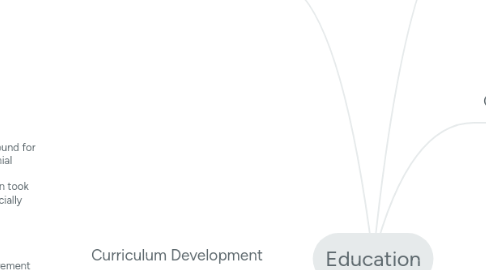Education
por Emma Dillon

1. Hidden Curriculum
1.1. The hidden curriculum consists of those things pupils learn through the experience of attending school rather than the stated educational objectives of such institutions
1.1.1. Ivan Illich
1.1.1.1. Schools provide four main functions: - Provision of custodial care (keeping children ‘off the streets’) - The distribution of people among occupational roles - The learning of dominant values - The acquisition of socially approved skills and knowledge
1.1.1.2. Content: - Organisation of Preschool - Attitudes - Values - School rules - School Curriculum
2. Curriculum Development
2.1. - The curriculum, i.e. ‘what is taught’ is a key site of struggle in Irish education - National schools used to be a battle ground for the hearts and minds of children re: colonial power vs Irish nationalism. - After independence - moral socialisation took precedence over all other concerns especially Religion, History and Irish - However religious ideals are no longer as influential in curriculum - Rather, encouraging the value of achievement and preparation for the labour market have become central dynamics in the curriculum.
2.2. Certain studies undertaken in Clondalkin (Mc Sorley, 1997) and Finglas (Fagan, 1995) found the curriculum unattractive and irrelevant to working class students. - The system therefore fails to reflect the reality of students from low income Irish families
3. Secondary School
3.1. Several recent initiatives at second level Transition year: - Leaving certificate vocational programme (LCVP) - Leaving Cert Applied Programme (LCAP) Some of these are aimed at retaining students who might otherwise leave
4. Basically, the hidden curriculum is teaching a child manners (like to wait their turn etc.) Without them even noticing that they're learning such things.
5. Purpose of Education
5.1. - To instill values - To promote social cohesion - To create equality - To promote personal freedom - To assist economic development
6. OMCYA
6.1. - Childcare Regulations - County Childcare Committees - National Childcare Organisations - Child minders
6.2. - Free pre-school - Community Childcare Subvention Scheme (CCS) - Childcare Education and Training Support - Programme (CETS)
6.3. - Provide a subsidised pre-school year to children in the year before they enter Primary school. - Replaced Early Childcare subsidy - 3 hours of pre-school per day, 5 days a week, and 38 weeks of the year - Uptake greater than 80%
7. ECCE
7.1. - Compulsory age for attendance – 6 - Pre-schools mostly run by voluntary/private sector - Lack of state investment linked to traditionally strong emphasis on the ‘informal sector’ for welfare provision
7.2. often out of the reach of families on low incomes - Some initiatives for disadvantaged groups exist E.g. ‘Early Start’
7.3. - No overarching funding system. - Limited state investment – maintains a divide - There is no overarching system for qualifications (changing with Free-preschool year)
8. Primary School
8.1. - Full-time education - AGE 6 - Half (49.2%) of 4 year olds (99.9%) 5 year olds - Schools run by religious orders, multidenominational schools and Gaelscoileanna - 56 nondenominational primary schools (Educate Together)


